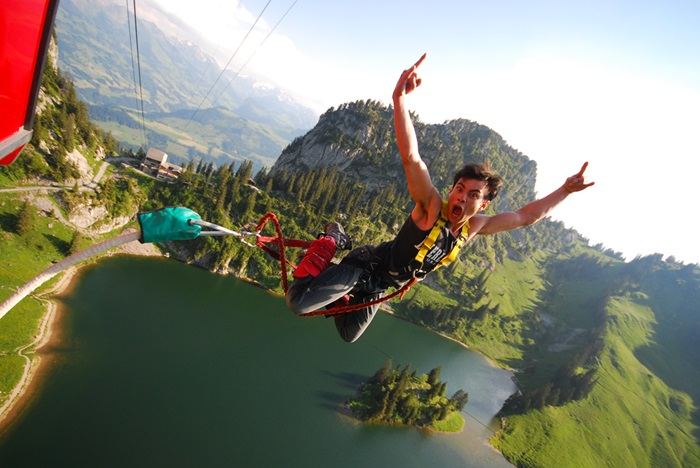Bungee jumping is an exhilarating extreme sport that combines the thrill of free-fall with the safety of controlled deceleration. One of the most crucial factors in ensuring a safe and enjoyable jump is the correct adjustment of the bungee cord length according to the jumper’s weight. In this article, we’ll delve into the science behind bungee cord length adjustment, providing a comprehensive guide to ensure both safety and thrill.
Understanding Bungee Cord Mechanics
The Physics of Bungee Jumping
Bungee jumping involves the use of a long, elastic cord attached to a platform or bridge. When a jumper leaps from the platform, the bungee cord stretches, absorbing the kinetic energy of the fall and gradually slowing the jumper to a stop before pulling them back up.
Cord Material and Spring Constant
The spring constant (kk) is a measure of the bungee cord’s stiffness. Different cords have different spring constants, which affect how much they stretch under a given force. For safety, it’s essential to use a bungee cord with the appropriate spring constant for the weight of the jumper.
Calculating Bungee Cord Length
Determining the Optimal Length
To calculate the optimal length of the bungee cord, several factors need to be considered:
Jumper’s Weight: Heavier jumpers will stretch the cord more than lighter jumpers.
Cord’s Spring Constant: Stiffer cords require different length adjustments compared to softer ones.
Platform Height: The height from which the jumper leaps affects how much cord is required.
The calculated length should include a safety margin. This margin accounts for variations in cord elasticity, environmental conditions, and unexpected forces during the jump. Typically, adding an extra 10-20% to the calculated length ensures that the jumper is safely decelerated.
Practical Considerations for Cord Adjustment
Measuring and Testing
Before a jump, it’s crucial to accurately measure and adjust the bungee cord length. This involves:
Weighing the Jumper: Ensure that the jumper’s weight is accurately measured.
Adjusting the Cord: Modify the cord length based on the weight and height of the jump. Use precise measuring tools and follow the calculated adjustments.
Regular Maintenance and Inspection
Bungee cords should be regularly inspected for wear and tear. Regular maintenance ensures that the cord remains reliable and performs consistently. Check for signs of fraying, stretching, or any other damage that might affect the cord’s performance.
Common Mistakes to Avoid
Underestimating Cord Length
One common mistake is underestimating the required cord length. This can lead to excessive stretching and potential safety hazards. Always ensure that the length accounts for both the jumper’s weight and a safety margin.
Using Incorrect Spring Constant Values
Using bungee cords with incorrect spring constants for the jumper’s weight can result in improper adjustments. Always use cords with known and appropriate spring constants for your setup.
see also: New Zealand: The Birthplace of Bungee Jumping
Ignoring Environmental Factors
Environmental factors like wind speed and temperature can affect the cord’s performance. Although these factors have a minor impact, they should still be considered when making final adjustments.
Conclusion
Adjusting the length of the bungee cord according to the jumper’s weight is a critical aspect of ensuring both safety and excitement in bungee jumping. By understanding the underlying physics, calculating the optimal cord length, and making necessary adjustments, you can enhance the overall jumping experience. Remember to regularly inspect and maintain the equipment to ensure its reliability. Proper preparation and safety measures are key to enjoying this thrilling extreme sport.
FAQs:
What is the best way to measure a bungee cord for safety?
To measure a bungee cord for safety, use precise measuring tools to adjust the cord length based on the jumper’s weight and platform height. Include a safety margin of 10-20% above the calculated length to account for variations in cord elasticity and environmental factors.
How often should bungee cords be inspected?
Bungee cords should be inspected before each jump for signs of wear and tear. Regular inspections help ensure the cord remains in good condition and performs reliably. Replace any cord that shows signs of damage or excessive wear.
Can the bungee cord length be adjusted during a jump?
No, the bungee cord length should be adjusted before the jump. Once the jump begins, the cord’s length and elasticity are fixed, so it’s crucial to make all adjustments and checks beforehand to ensure safety.
How does the environment affect bungee jumping?
Environmental factors such as wind speed and temperature can slightly impact the bungee cord’s performance, but these effects are generally minor. Ensure that all equipment is inspected and adjusted considering these factors, particularly in extreme weather conditions.
related topics:
- What Factors Have to Be Taken into Consideration When a Person Wants to Go Bungee Jumping?
- Top 10 Highest Bungee Jumping in the World

